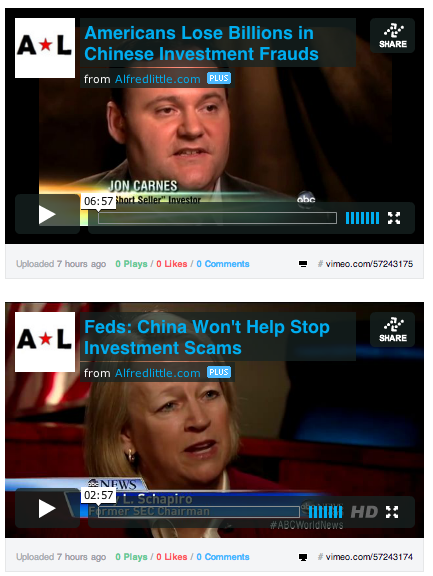by Alexander Ljungqvist[1] and Wenlan Qian[2], Working Paper 19834 of the National Bureau of Economic Research
In this NBER Working Paper, Alexander Ljungqvist and Wenlan Qian (“L&Q”) independently analyzed 332 reports published by 17 small activist short-sellers (who L&Q refer to as “shallow-pocketed arbitrageurs”) spanning from 2006 until 2011. L&Q made the following observations:
- Short sellers spend considerable money conducting their research while facing high lending fees, difficulty borrowing shares, and expensive put option premiums.
- Despite these challenges, short sellers are quite successful in correcting the overpriced stocks: “On average, the prices of target companies in our sample fall by 21.9% over 3 months and by 56.8% over 12 months, net of market movements.”
- Short sellers overcome their high costs by publishing very detailed reports revealing new negative information that, only if credible, results in investors selling their holdings causing large share price declines.
- With considerable accuracy, the short sellers’ reports are usually proven to be true: “For example, 35% of targets are subsequently delisted, 38% replace their auditors or see their auditors resign, and 23% restate earnings. In fact, in only 19% of cases do subsequent investigations by the SEC, the Department of Justice, or a stock exchange disprove the alleged facts contained in the reports.”
- Only short sellers “…with a history of making claims that are subsequently confirmed are able to induce the longs to sell and thereby put pressure on a target’s share price. And it is only credible reports that generate profits for the [shorts], net of shorting fees: without credibility, prices do not fall significantly.”
- Reports “…that present new facts previously unknown to investors (e.g., resulting from on-the-ground detective work) result in longs selling and rapid price corrections whereas reports that merely reinterpret known data do not.”
- The three largest publishers of reports analyzed by L&Q were Citron Research (106), Alfred Little (37), and Asensio & Co. (34).
- Chinese companies accounted for 51.3% of the sample. However, L&Q asserts that their findings were “qualitatively unchanged” if they remove the Chinese companies from their sample.
- The three short sellers with the “largest immediate market impact” were Chimin Sang (-19.9% on 3 reports), Alfred Little (-19.2% on 7 reports), and Muddy Waters (-18.0% on 5 reports).
- The three short sellers with the largest market impact measured over three months were Asensio & Co. (-58.9% on 4 reports), Absaroka Capital Management (-54.1% on 2 reports), and GeoInvesting (-39.8% on 8 reports).
- Short sellers “…also face the risk of being sued by their targets.” However, the “…very real risk of lawsuits will, to some extent, keep the [shorts] from making claims they cannot substantiate.”
- The “…mean cumulative abnormal return is -56.8% over the 12 months following the release of a report, with 80 of the 113 targets experiencing negative abnormal returns. This suggests that the information the [shorts] release usually proves correct.”
- L&Q independently analyzed each short seller’s track record to gauge the credibility of the reports. L&Q’s calculated an 81% credibility rating for the entire group of short sellers and a 100% credibility rating for Alfred Little.
L&Q’s research “…illustrates why financial markets need short sellers to function well.” Furthermore “…the short sellers in our sample are information producers who help correct mispricing and thereby help make markets more efficient. This is all the more remarkable given that many targets in our sample were held by highly sophisticated investors who apparently did not spot the overvaluation until it was too late.”
I strongly concur with L&Q’s findings and believe their detailed analysis proves the value of the reports published on Alfredlittle.com. I welcome L&Q to update their analysis at some point to include 2012 and 2013 short seller reports, as well as to calculate the price declines of short seller targets over even longer periods of time (such as one or two years after publication). This is imperative given that over longer periods of time the “market” more accurately gauges the merits of any valuation dispute.
It is in the best interests of investors that the exchanges and the SEC find ways to better engage small activist short sellers in their fight against securities fraud. The current Dodd-Frank Whistleblower program has, to date, failed to substantively reward short seller whistleblowers. The exchanges are less interested in protecting investors and more keen to protecting themselves from legal entanglements that may arise from delisting any given company as a result of short seller allegations. Yet the short sellers, as L&Q have conclusively shown, are usually right.
Note: All quotations in this review are copyright 2014 by Alexander Ljungqvist and Wenlan Qian. The public may purchase L&Q’s report online in .pdf format from SSRN.com ($5) for electronic delivery. Journalists can obtain copies for free.
